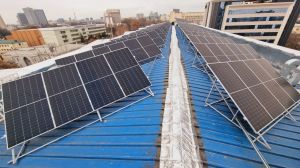In accordance with the law of the Republic of Uzbekistan, the Ministry of Energy is responsible for implementing modern energy-efficient technologies in government entities and monitoring the results.
To implement these efficiencies, the Ministry uses:
- For Petroleum Products and Gas: Uzneftegazinspekziya
- For the Electricity Industry: Uzenergoinspekziya
Uzneftegazinspektziya
The main tasks and functions of Uzneftegazinspektsiya are:
- Ensuring compliance with laws governing hydrocarbon extraction and production;
- Measures for the efficient use of energy for retail and business consumers;
- Developing, implementing and monitoring government energy saving programmes;
- Coordinating energy surveys;
- Introducing energy-saving technology; and
- Accelerating energy efficiency improvement processes in Uzbek companies
Uzneftegazinspeksiya’s activity follows the Resolution of the President of the Republic of Uzbekistan on 26 May 2017.
The Resolution (No. PP-3012) is titled “On the Programme of Measures for the Further Development of Renewable Energy, Energy Efficiency Improvement in the Economic and Social sectors for 2017-2021.”
Uzneftegazinspeksiya has overseen the transfer of domestic cement plants and brick factories to the ‘dry’ method of production. It also organizes workshops for the production of slaked lime, greenhouses and the use of alternative fuels, such as coal.
During 2018 and 2019, regular communications were undertaken with the media about the advantages of alternative fuels. In this period, 25 workshops were held involving 1,200 companies. Other media activities included:
- Two media tours about the production of baked bricks
- Ten videos on the advantages of using coal as fuel were broadcast on Uzbekistan 24 and Sevimli TV channels
- Articles on social media ("Kun.uz", "gazeta.uz") and local publications were also published
As a result, 202 (36%) plants for production of baked bricks and 155 (27%) greenhouses were switched to the use of coal, which saved 360,000,000 cubic meters of natural gas per year.
A study was also conducted on compliance with criteria for energy saving at companies producing baked bricks, lime, cement and in greenhouses.
This study was in accordance with a Decree of the President of the Republic of Uzbekistan (No. UP-4335) from 23 May 2019.
The study led to more alternative fuels (coal) being used at manufacturing enterprises
that did not meet criteria for energy saving. The savings totalled more than 5 billion cubic meters of natural gas per year.
Uzenergoinspeksiya
Uzenergoinspeksiya develops basic sectors of the economy, improving their energy efficiency through the use of electricity, heat and coal.
Uzenergoinspeksiya also modernizes outdated electrical equipment and utilizes the latest technologies.
In the first half of 2019, 633 units of electrical equipment were replaced – saving 182 million kW/h in electricity consumption. This also delivered an average reduction in production costs of 0.6% and a 5.6% decrease electricity production costs.
By the end of 2019, it is planned to replace 1,200 units of obsolete electrical equipment and achieve savings of 647 million kW/h.
This activity is in line with:
- A December 2016 Decree of the President of the Republic of Uzbekistan (no. PP-2692)
- “On Additional Measures for Accelerated Replacement of Physically Worn Out and Obsolete equipment, as well as Reducing Production Costs of Industrial Enterprises.”
- A May 2017 Resolution of the President of the Republic of Uzbekistan (no. PP-3012)
Uzenergoinspeksiya also approved energy audit programmes for 13 enterprises. The audits reveal the scope for further energy efficiencies and/or the potential for secondary energy sources.
This activity is line with laws for the ‘Rational Use of Energy’ and Rules (No. 164) for conducting energy surveys approved by the Cabinet of Ministers in the first half of 2019.
Uzenergoinspeksiya also studies global trends in reducing energy intensity and seeks areas for the use of renewable energy sources in Uzbekistan.
In the first half of 2019, Uzenergoinspeksiya held:
- 12 training workshops across the country, with over 500 industrial enterprises
- Four press conferences
- Meetings to promote reduced energy intensity and improved energy efficiency
It also distributed collateral (including posters) on energy efficiency and saving resources. Five videos were broadcast, eight TV and radio broadcasts were made, and 17 announcements were published in mass media/on social media.










